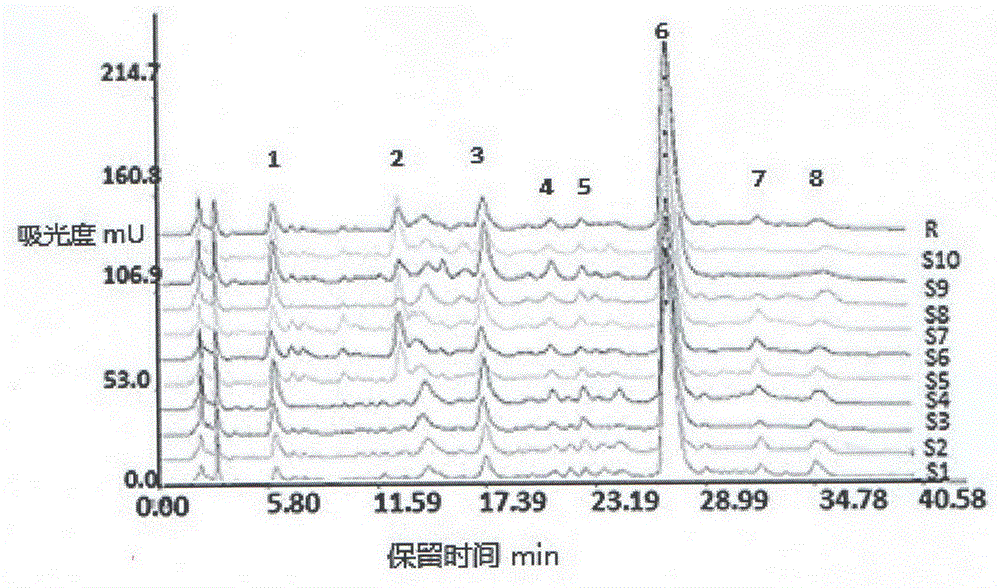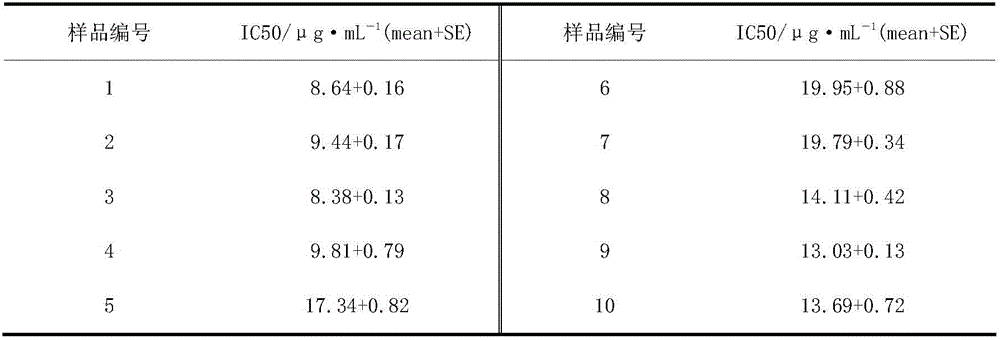Applications of safflower extract with definite spectrum-effect relationship
A safflower extract and extract technology, applied in the field of safflower extract, can solve problems such as inability to effectively express correlation, no curative effect, instability and the like
- Summary
- Abstract
- Description
- Claims
- Application Information
AI Technical Summary
Problems solved by technology
Method used
Image
Examples
Embodiment 1
[0032] The safflower samples from different sources were collected from the main producing areas of Xinjiang safflower: Changji Jimsar County, Tacheng Yumin County, Yining Huocheng County, a total of 10 batches.
[0033] Weigh 15g of the safflower medicinal material and pulverize it, add 40 times the amount of distilled water, soak in a water bath at a temperature of 70°C for 30 minutes, reflux extraction for 3 times, each time for 40 minutes, and combine the extracts;
[0034] Concentrating the extract under reduced pressure to a relative density of 1.01-1.05g / mL to obtain a concentrate;
[0035]Load the concentrated solution onto the AB-8 macroporous adsorption resin column. The ratio of the diameter to the height of the resin chromatography column is 1:9, and the elution rate is 1mL / min. When the reaction is basically negative, elute with 10% ethanol at a volume concentration, collect the fractions, concentrate the extract to obtain 628 mg of yellow powder, dry and store at...
Embodiment 2
[0037] Weigh 15g of the safflower medicinal material and pulverize it, add 20 times the amount of distilled water, soak in a water bath at a temperature of 60°C for 120 minutes, and extract once under reflux for 100 minutes to obtain an extract;
[0038] Concentrating the extract to a relative density of 1.01-1.05g / mL to obtain a concentrate;
[0039] Load the concentrated solution to the AB-8 macroporous adsorption resin column. The ratio of the diameter to the height of the resin chromatography column is 1:9, and the elution rate is 1mL / min. When the reaction is basically negative, elute with volume concentration 10% ethanol, collect the fractions, concentrate the extract to obtain 556 mg of yellow powder, dry and store at room temperature to obtain the safflower extract.
Embodiment 3
[0041] The biological activity screening of the safflower extract that embodiment 1 obtains as the medicine of protein tyrosine phosphatase inhibitor or the purposes of health product:
[0042] Screening method: Use disodium p-nitrophenyl phosphate (pNPP) as a substrate, and determine the activity of PTP1B inhibitors according to the color reaction produced by protein tyrosine phosphatase 1B (PTP1B) hydrolyzing the phosphate group of pNPP. PTP1B inhibitory activity assay reaction system: 179 μL of PTP1B dilution, diluted with phosphate buffered saline solution PBS of pH 7.4, incubated at room temperature for 5 min, 1 μL of test sample or positive control sample (make the sample into a concentration gradient) or dimethyl sulfoxide (DMSO ) 1 μL, mix well and incubate at room temperature for 5 minutes, add 20 μL of 35 mmol / L pNPP, the total volume is 200 μL, incubate at 25 °C in the dark for 30 min, then stop the reaction, measure the absorbance at 405 nm, and use the enzyme-free ...
PUM
 Login to View More
Login to View More Abstract
Description
Claims
Application Information
 Login to View More
Login to View More - R&D
- Intellectual Property
- Life Sciences
- Materials
- Tech Scout
- Unparalleled Data Quality
- Higher Quality Content
- 60% Fewer Hallucinations
Browse by: Latest US Patents, China's latest patents, Technical Efficacy Thesaurus, Application Domain, Technology Topic, Popular Technical Reports.
© 2025 PatSnap. All rights reserved.Legal|Privacy policy|Modern Slavery Act Transparency Statement|Sitemap|About US| Contact US: help@patsnap.com



